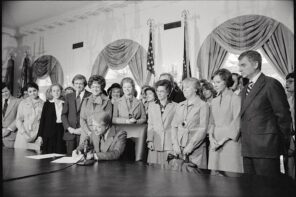Jeanne Prentice, a South Dakota-based certified nurse-midwife, is a conservative Christian who is, in a manner of speaking, pro-choice.
Most of Prentice’s clients are “ranch people” and Christians like herself who incorporate prayer into childbirth. “To me, this is what I know,” she says. “I only know one God, and I only know one Lord, and I only know one way to pray.” When labor isn’t progressing well, she uses prayer to help the process along. “Everybody will lay hands on the mother, and we invite the Holy Spirit into the event,” she explains. “This will happen spontaneously. There’s nothing more rejuvenating and encouraging for a mother than listening to people pray for her.”
Prentice, like many midwives practicing in rural Christian communities, is “naturally pro-life,” but she sees legal access to home birth care as a “choice” issue. “I fully believe in a woman’s right to birth with whom she chooses, where she chooses,” Prentice says. In her view, however, abortion is a sin. “I do not believe that anyone has a right to take a life. Period. And I think it goes against the nature of what midwifery is.”
A number of articles have recently cropped up reckoning with the relative merits of home and hospital births. The New York Times Magazine ran a piece on home birth trailblazer Ina May Gaskin, for example, while The Atlantic focused on low-tech births, and The Daily Beast’s Michelle Goldberg looked at the risks of home births (which prompted this response on Slate). These articles reflect an emerging consensus that home birth has become more common and less countercultural, a consensus supported by CDC data showing that between 2004 and 2009 home births increased by 29%. The home birth movement has been galvanized by the fight for legislation that ensures better access to home birth care, yet some birth advocates have found themselves among strange bedfellows: individuals who disagree—often vehemently—about abortion, even as all parties emphasize the centrality of “choice” to the home birth movement.
Midwifery Care and Reproductive Choice
A world away from Christian prayer-based midwifery, one finds Marni Kotak, a woman who gave birth publicly in a Brooklyn art gallery, or Una Lamarche, a Brooklyn-based journalist who chronicled her home birth—in detail—on her blog The Sassy Curmudgeon. The population of women who choose home birth has never been more varied or more public about their decision. Meanwhile, the group of practitioners who support women during pregnancy and birth are taking on new identities, like “full-spectrum doulas” who care for women throughout the pregnancy spectrum, which can mean support during abortion, miscarriage, stillbirth, fetal anomaly, or childbirth.
Increasingly, pro-choice advocates argue that choice in childbirth should be subsumed under the umbrella of reproductive justice and human rights; that women of all ethnic and socioeconomic backgrounds should have access to the best in reproductive health care, whether that means a safe abortion or the right to quality childbirth care in hospital, clinic, or home environment. The recent onslaught of feticide laws and personhood bills at the state level has made the connection between anti-choice legislation and birthing rights palpable, as even women who do not plan to have an abortion have been imprisoned or forced to undergo unwanted medical procedures under the auspices of anti-abortion laws.
“Radical Doula” Miriam Pérez, who identifies as pro-choice, is co-founder of the Doula Project, an organization that provides doula care to women across the pregnancy spectrum. When she first became a birth advocate, Pérez was confused about the apparent silence surrounding the topic of abortion until she realized she was part of a community with a number of conservative religious midwives and doulas who do not believe that abortion should be legal. “I realized the silence on abortion wasn’t about agreement, but dissention,” Pérez says.
That Prentice and Pérez both use the word “choice” when discussing childbirth care can be confusing, until one realizes that, in this context, choice refers to a woman’s right to safe and affordable birth options. In some states certified nurse-midwives (CNMs) and certified professional midwives (CPMs) are not legally permitted to attend home births, so women who would otherwise desire a midwife-assisted home birth choose between an unassisted birth or a hospital birth. To complicate the issue even further, since insurance coverage is another factor that dictates what type of birth a woman has access to, “choice” also refers to insurance reform issues, in addition to the right to informed consent over procedures such as episiotomy, cesarean section, and induced labor.
But when the language of choice extends to the pregnancy spectrum, pro-life and pro-choice individuals within the birth advocacy community find themselves at odds. For Pérez, the division between different stages of pregnancy is illusory at best. “Doing this work makes me realize it’s not black and white,” Pérez says. “A lot of people at abortion clinics are actually having miscarriages… so trying to draw that distinction just doesn’t work for the way people lead their lives, and the way that abortion works. Midwifery care was always tied to abortion care. This connection is not a new thing. The current political environment in the U.S. silos abortion from anything else.”
For Prentice, birth advocates who explicitly place childbirth care along the spectrum of reproductive care are using a framework that doesn’t make sense. “This idea that we should be in bed with people who are pro-choice because we’re allowing women to choose where to give birth—it’s actually pretty disgusting,” Prentice says. “That allowing a woman to give birth where she chooses has anything to do with killing a baby.”
“Choice” and “Informed Consent”
During the 1970s, an era perceived as the heyday of “crunchy” home birth advocacy, the divide between pro-life and pro-choice midwives was less conspicuous and presented fewer pragmatic problems since midwives tended to work in confined communities. “At that time, you had very religious conservative Christians practicing home births, and then you also had this hippie movement, these countercultural, anti-establishment individuals,” says Melissa Cheyney, a licensed midwife and assistant professor of medical anthropology at Oregon State University. The growing number of women seeking a secular midwife has created a gap in care, however. In some areas the preponderance of Christian midwifery, in tandem with restrictive laws, can make it difficult for secular women to locate a well-matched midwife.
Anna Waterland-Dykstra, a nurse and director of community options at the Spearfish Family Planning clinic of the South Dakota Department of Health, says that due to limited midwifery options in her state, some women choose to give birth unassisted or in the hospital. Others cross the border to Montana, a state which recognizes the licensing of CPMs, which in turn affords them the opportunity to publicly advertise their services. But in South Dakota, she says, “there are women who aren’t interested in a Christian approach to midwifery care, and there are very few options for them that are out in the open. In Montana, there are more options in general for midwifery care, including whether you want a religious midwife.” (A similar border-crossing situation exists in Wisconsin, a state that recognizes CPM licensure yet is bordered by states that don’t.)
Some view the political variability of home birth caretakers and advocates as a source of strength for the movement. Katherine Prown, campaign manager of The Big Push for Midwives, an advocacy organization for expanding access to out-of-hospital care, says that home birth advocacy is “probably the only grassroots movement that includes roughly equal numbers of pro-life and pro-choice individuals. We often hear shock from legislatures, saying they have never before seen these two groups come together on the same piece of legislation.”
Shaye Miller, previously the member chairwoman at Nebraska Friends of Midwives, says that the issue usually gets quickly “dropped” when abortion is brought up amongst midwifery advocates. “It ends up turning into a partisan turf battle rather than the promotion of midwifery,” Miller says. “I always go back to the scientific, informed consent angle. This angle has never let me down. It’s never led me astray so far.”
Birth advocates of all stripes have come to embrace this catchall expression, “informed consent,” in order to avoid using the similar (but loaded) term, “informed choice.” For the most part, the home birth community works under a mutual, unspoken agreement to avoid the divisive topic of abortion, even those who are separately active in the realm of abortion politics. “We agree to disagree on the issues we don’t talk about,” Prown says, “which are religion and abortion.”




